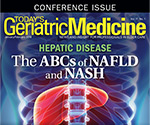 |
It’s well known that falls contribute to fractures, with 90% of hip fractures resulting from falls, according to the International Osteoporosis Foundation. Each year, one-third of people over the age of 65 experience a fall, with approximately 10% to 15% of falls in the elderly resulting in fracture. And an alarming statistic shows nearly 60% of those who had fallen the previous year will fall again. Although no effective cure for loss of bone mass exists, researchers are making inroads in identifying methods of reducing fracture incidence in women with osteoporosis.
In addition to reading our e-newsletter, be sure to visit Today’s Geriatric Medicine’s website at www.TodaysGeriatricMedicine.com, where you’ll find news and information that’s relevant and reliable. We welcome your feedback at TGMeditor@gvpub.com. Follow Today’s Geriatric Medicine on Facebook and Twitter, too.
— Barbara Worthington, editor |
 |
 |
Drug Combo Cuts Fracture Risk for Women With Osteoporosis
Taking a medication that builds bone mass followed by one that maintains it can significantly reduce the risk of fracture among postmenopausal women.
Osteoporosis is a serious condition affecting both women and men, though postmenopausal women are particularly susceptible. The progressive loss of bone mass puts those with the condition at greater risk for fracture.
To date there is no effective treatment or cure. This is the reason the promise of this study, demonstrating that bone mass can be regenerated with the novel bone anabolic medication romosozumab and sustained with antiresorptives, is of such importance.
Over a two-year period, researchers randomly assigned 4,093 women with osteoporosis and a fragility fracture to one of two groups.
Full story » |
 |
 |
Hepatic Disease: The ABCs of NAFLD and NASH
Age-related changes in the liver combined with significant increases in chronic conditions such as obesity, hypertension, hypercholesterolemia, and diabetes increase older adults' risk of diseases of the liver. Read more »
New National Standards Improve Diabetes Self-Management
Updated guidelines published by the American Diabetes Association provide a blueprint for successful diabetes management through enhanced education and support services. Read more »
Osteoporosis Patients With Comorbidities: All Foods Can Fit
Data from well done studies support an "all foods (and supplements) can fit" approach to counseling osteoporosis patients with comorbidities. Read more » |
 |
 |
AiA18 Offers Abundance of Aging Education
By Heather Hogstrom
The American Society on Aging’s 2018 Aging in America Conference (AiA18) will take place March 26–29 in San Francisco. Home of the iconic Golden Gate Bridge, San Francisco has much for visitors to experience. Union Square, where the conference will be held, is a popular shopping destination. It’s served by the cable car system, which is one of San Francisco’s most popular attractions, but the city is also easily explored on foot.
AiA18, which offers up to 20 CE credits, provides plenty to explore in the exhibit hall and a variety of topics to learn about in the educational sessions. Attendees with an interest in a specific subject can attend a “conference within a conference” by choosing a series of programs and workshops that focus on the following areas:
Full story » |
 |
|
|
 |
Hospitals Often Ill Equipped
for Dementia Patients
An article in the Boston Globe laments the fact that hospitals typically are ill equipped to deal with patients with Alzheimer’s disease.
Researchers Ponder Connection
Between Holidays and Dying
Do people delay death as they await a significant event? Anecdotal evidence may support this occurrence, according to an article in The Washington Times.
Dutch Program Teaches Fall
Technique, Prevention
An article in The New York Times describes a Dutch program that teaches elders to safely navigate treacherous ground and how to fall to avoid serious injury.
Algorithm Analyzes Probability of Death
Are researchers approaching a point at which they’ll accurately be able to predict the timeframe of death for terminally ill patients? An article in The New York Times Magazine suggests that it’s likely. |
 |
|
